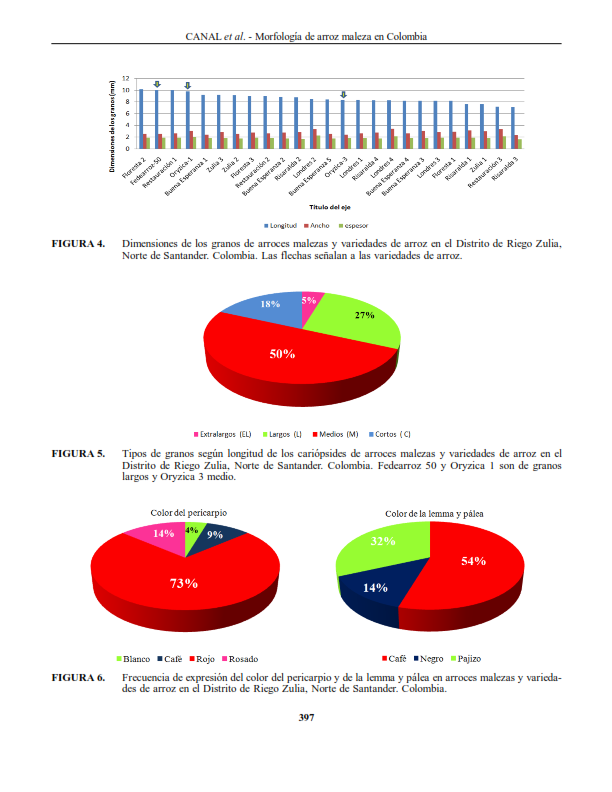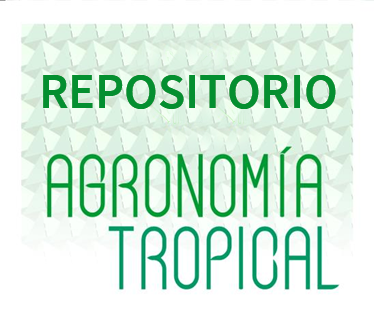MorphologMorphologic characterization of populations of rice weeds in Zulia river irrigation district, Norte de Santander Departmenic characterization of populations of rice weeds in Zulia river irrigation district, Norte de Santander Department, Colombia
Abstract
Rice weeds (WR) dramatically reduces both yield and quality paddy milled rice, and also reduces farm value. The objective of this study was to characterize some populations of WR at Zulia River Irrigation District, Norte de Santander Department, Colombia. The experiment consisted of 22 WR and three rice varieties (Oryzica-1, Oryzica-3, and Fedearroz-50). A randomized block design with three replications was utilized and 21 attributes of plants and seeds were evaluated. Regarding plant type, results showed that 50% of WR had intermediate growth habit, 36.40% good tillering, 45.45% moderate lodging and 31.80% moderate grain shattering; 77.27% of WR had similar or shorter plant height than rice varieties (112.30 - 87.30 cm), and 54% of them had flowering time comparable to rice varieties 65.71 to 79 days after cultivated field. As regards as grains: 45.45% of WR was long-grain type like Fedearroz 50; 95.45% of them with the apex of the lemma and pale angle between 0-10°, similar to Fedearroz 50. All WR grains had lemma and pale pubescent and high variation of paddy grain sizes (7,13-10,15 mm); 63.64% had awn of various sizes. 50% of AM had grain caryopses length rated as medium grain, like Fedearroz 50 and Oryzica 1 (5.6 to 6.5 mm). These results suggest that WR might have been introgressed in cultivated rice probably due to hybridization.
Downloads
References
• Agudelo, G y G. León, 1993. El arroz rojo en la multiplicación de semillas. FEDEARROZ-Colombia. Revista Arroz 349(38):30-31.
• Canal, R. 2000. Caracterización morfofisiológica de biotipos y evaluación de niveles de infestación de la maleza arroz rojo (Oryza sativa), en el Distrito de Riego del Río Zulia, Norte de Santander, Colombia. Tesis de Maestría. Maracay, estado Aragua. Venezuela. Universidad Nacional Experimental del Táchira (UNET). 80 p.
• Castillo, J. 2006. Evaluación de la contaminación con arroz rojo en la producción de semillas y granos de arroz en el estado Portuguesa. Tesis de Grado. Maracay, estado Aragua. Ven. Universidad Central de Venezuela. Facultad de Agronomía. 90 p.
• Davaus, Y. y J. Zamora. 2005. Evaluación de la hibridación natural entre la variedad de arroz zeta 15 y el arroz rojo negro sin arista. Trabajo de grado. Aragua, Ven. Universidad Central de Venezuela. Facultad de Agronomía. 75 p.
• Diarra, A, R., Smith and R., Talbert. 1985. Growth and Morphological Characteristics of Red Rice (Oryza sativa) biotypes. Weed Science. 33:310-314.
• Do Lago, A. A. 1982. Characterization of Red Rice (Oryza sativa L.) Phenotypes in Mississippi. Ph.D. dissertation. Mississippi State, MS Mississippi State University. 143 p.
• Federación Nacional de Arroceros (FEDEARROZ). 2000. II Censo Nacional Arrocero. Santafé de Bogotá. 30-46 p.
• Fischer, A. and A. Ramírez. 1993. Red Rice (Oryza sativa): Competition studies for management decisions. Int. J. Pest Manage. 39:133-138.
• Fischer, A. 1997. Manejo integrado de malezas del arroz. In: MIP en Arroz. Caracas Fundación Polar, FEDEARROZ, CIAT. p. 31-49.
• García, G. y R. Regino. 1995. Comparación de índices de crecimiento y desarrollo de algunos tipos de arroz rojo y de las variedades Oryzica-1 y Oryzica Llanos-5. Federación Nacional de Arroceros (FEDEARROZ). Revista Arroz 44(394):28-35.
• Gealy, D. 2005. Gene movement between rice (Oryza sativa) and weedy rice (Oryza sativa) - AU.S. temperate rice perspective. In: J. Gressel, ed. Crop fertility and volunteerism. Boca Raton: CRC press, Taylor and Francis Group. 323-354 p.
• Gómez, O. 2002. Caracterización morfofisiológica y quimiotaxonómica de las especies del complejo de malezas arroz rojo de las principales zonas productoras de arroz en Venezuela. Tesis de grado. Maracay, estado Aragua. Ven. Universidad Central de Venezuela. Facultad de Agronomía. 105 p.
• Hernández, R. 1991. Situación y perspectivas del sector arrocero en Colombia en: Memorias del primer encuentro Andino de arroceros. Integración Andina del sector arrocero. Santafé de Bogotá. 75-89 p.
• Langevin, S. A., K. Clay and J. B.Grace. 1990. The incidence and effects of hybridization between cultivated rice and its related weed red rice (Oryza sativa L.). Evolution 44:1 000-1 008
• Lentini, Z. and A. Espinoza. 2005. Coexistence of Weedy Rice and Rice in Tropical America - Gene Flow and Genetic Diversity. In: Crop Ferality and Volunteerism: A Threat to Food Security in the Transgenic Era. J. Gressel, ed. CRC Press. 303-319 p.
• Messeguer, J., V. Marfa, M. Catala, E. Guiderdoni and E. Mele. 2004. A field study of pollen mediated gene flow from Mediterranea n GM rice to conventional rice and the red rice weed. Mol. Breed. 13:103-112.
• Montealegre, F. y J. Clavijo. 1992. Tipos de arroz rojo en Colombia. Federación Nacional de Arroceros (FEDEARROZ). Revista Arroz 40(375):16-23.
• Morishima, H. and H. Oka. 1975. Comparison of growth patterns and phenotypic plasticity between wild and cultivated rice strains in Japan. J. Genetics 50:53-65
• Muñoz, G., G. Giraldo y J. Fernández. 1993. Descriptores Varietales: arroz, fríjol, maíz, sorgo. Centro Internacional de Agricultura Tropical (CIAT ). Palmira. Colombia. 15-44 p.
• Noldin, J. J. Chandler and G. McCauley. 1999. Red Rice (Oryza sativa) Biology I. Characterization of Red Rice Ecotypes. Weed Technology 13(1):12-18.
• Oka, H. I. and W. T. Chang. 1961. Hybrid swarms between wild and cultivated rice species, Oryza perennis and O. sativa. Evolution 21:418-430.
• Ortiz, A. 1997. Caracterización morfofisiológica y quimiotaxonómica de ecotipos de arroz rojo y variedades de arroz en Venezuela. Tesis de Postgrado en Agronomía. Maracay, estado Aragua. Ven. Universidad Central de Venezuela. Facultad de Agronomía. 117 p.
• Ortiz, A. y T. Budowski. 1998. Estudio preliminar de la incidencia de arroz rojo y otras malezas en el arrozal venezolano. Investigaciones Agrícolas - DANAC (3):1-1.8.
• Ortiz, A. 2005. Caracterización morfofisiológica de genotipos de arroz rojo provenientes del programa de certificación de semilla de arroz en el estado Portuguesa año 2004. Trabajo Especial. Doctorado de Ciencias Agrícolas. Maracay, estado Aragua. Ven. Universidad Central de Venezuela. Facultad de Agronomía 126 p.
• Ortiz A., O. Gómez y C. Ramis. 2004. Caracterización bioquímica de poblaciones del complejo de maleza arroz rojo en Venezuela. Agronomía Trop. 54(3):257-273.
• Ortiz, A., A. Pérez, J. Ochoa y J. Vicente Lazo. 2007. Caracterización del arroz rojo proveniente de lotes de semilla de arroz. Parte I. Agronomía Trop. 57(3):147-156.
• Ortiz, A., R. Miranda, C. Ramis y R. Figueroa. 2007. Caracterización morfológica de una población F2 obtenida del cruce natural entre un cultivar arroz y un arroz rojo (PARTE I). Agronomía Trop. 57(3):157-169.
• Ortiz, A., Albert Jean Fischer, Chris Greer, Barbara Schaal, James Eckert, María Dolores Osuna and Emilio Laca. 2008. Arroz Maleza en California. In: Memorias XVIII Congreso de la Asociación Latinoamericana de Malezas (ALAM) y XXVI Congresso Brasileiro da Ciência das Plantas Daninhas. Ouro Preto Minas Gerais. Brasil. CD-Room. 6 p.
• Peña, J. 1999. Caracterización morfológica y taxonómica de las especies involucradas en el complejo de malezas denominado arroz rojo (Oryza: Poaceae) de las zonas arroceras de venezolanas. Tesis de Grado. Maracay, Ven. Universidad Central de Venezuela. Facultad de Agronomía. 88 p.
• Shivrain, V., N. Burgos, M. Anders, S. Rajguru, J. Moore and M. Sales. 2007. Gene flow between Clearfield TM rice and red rice. Crop Protection 26:349-356.
• Valverde, B. 2005. The Damage By Weedy Rice -Can Feral Rice Remain Undetected. In: Crop Ferality and Volunteerism: A Threat to Food Security in the Transgenic Era. J. Gressel, ed . CRC Press. 279-294 p





